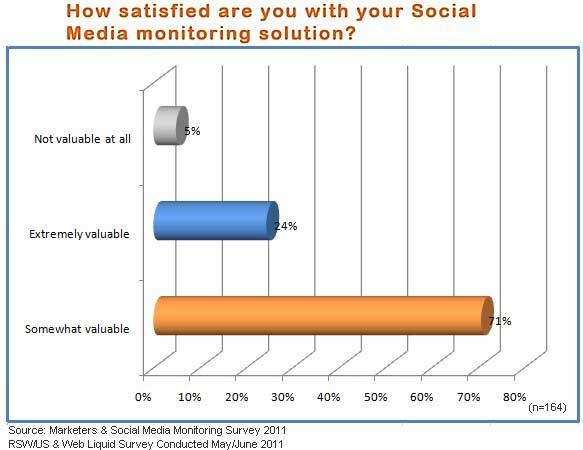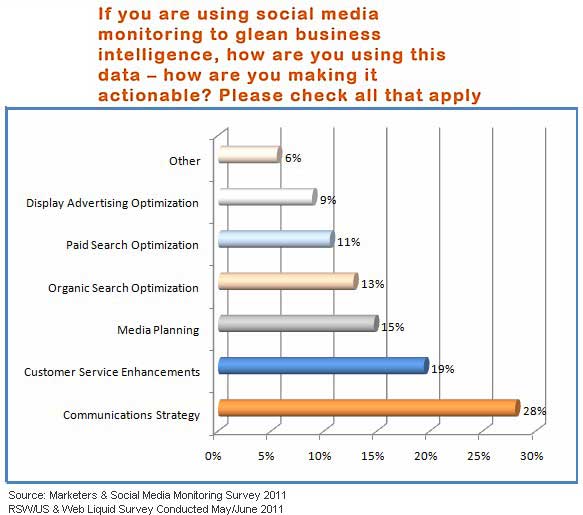New research by Web Liquid and RTW/US amongst 237 marketing executives in middle-large and large companies (revenue > $51MM), has shown that just 24% of the interviewed found the Social Media monitoring tools they used were “Very Valuable”. Digital marketers who use paid Social Media monitoring solutions are twice as likely to be "extremely satisfied" as those who use a free solution, according to the study.
The results were surprising in a couple of ways:
What tools are you using for Social Media monitoring

Almost half of the organizations are still using Google Alerts. This is surprising when comparing it with the type of organizations and its yearly revenue. Besides this result, one on five is not even monitoring Social Media. The usage of free tools/Google Alerts could be part of the dissatisfaction.
First of all Google Alerts is far from complete in terms of returned results, secondly it’s intensive manual labor to extract intelligence from it to be really efficient and effective.
The next results show that the intelligence that is extracted is mainly tactical and regarding communications:

The purposes of the intelligence are limited, on tactical marketing level and within the fields of communications. This whilst it has much more applications, think of Social Media Research, which departments have challenges and/or chances, understanding ROI, spotting unmet needs and pinpointing the innovators and much more.
Not only can Social Media inform Communication Strategy as mentioned in the chart, it can also inform “higher” level strategies because Social Media data is full of customer insights, market- and competitive intelligence. Fast iterative adjustments to strategy are made possible.
The limited scope and tactical application could be another part of the dissatisfaction.
Cooperative Intelligence
Besides the aforementioned limitations and dissatisfaction, there’s a third aspect that has impact on the efficiency and effectiveness of Social Media tools/data. It’s being described by the concept of Cooperative Intelligence:
Many companies think they are conducting real-time competitive intelligence since they monitor the competitive environment continuously on the Internet and increasingly through social media such as Twitter, LinkedIn and Facebook as well as industry specific forums or social networks like Ning. While monitoring is the foundation of real-time competitive intelligence, it is not actionable. The action you take in real-time will give you a competitive advantage. As David Meerman Scott said at our AIIP conference, “Speed and agility bring competitive advantage…Act now before the window of opportunity vanishes.”
and
However, CI managers can inform people in our companies in real-time, and in areas where we have more knowledge, make recommendations for action. The balancing act in our job is to offer cooperative intelligence: don’t inundate people with too much information, just what you know is important to them.
In relation to the Social Media research, the CI manager can be replaced by anyone who’s responsible for Social Media within the organization. Efficient workflow of the relevant information to the correct person/department is key for Social Media intelligence to be effective. If this doesn’t happen, the “speed and agility” where Meerman Scott talks about, disappears.
The organizational pillars
The three above mentioned reasons for dissatisfaction can be placed within the three organizational pillars: Technology, Processes and People.
If there’s not a strategy for Social Media incorporation within the organization, the Social Media monitoring tools (Technology), purposes of Social Media intelligence (People) and speed of intelligence (Processes) can be ineffective resulting in disappointing Social Media results.
Social Media hasn’t got a one-size-fits-all solution, this counts for monitoring tools as well.
Gianluigi Cuccureddu is Managing Partner at the 90:10 Group.
Recent Posts
Read more: http://www.businessinsider.com/social-media-intelligence-not-utilized-to-the-fullest-competitive-advantages-diminishes-2011-8#ixzz1VlNi1J7o
No comments:
Post a Comment